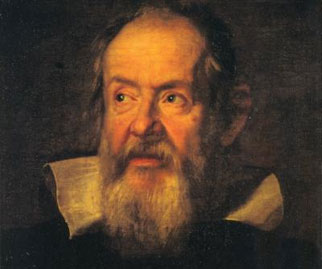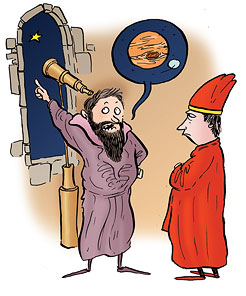Galileo and how he understood the Bible
Galileo was born in Italy around 500 years ago (in 1564). He is often called ‘the father of modern science’ because he recognised the value of doing experiments as a way to discover how nature works.
Galileo believed that science and religion are compatible ways of thinking about the universe. One of his favourite phrases was a line he borrowed from a librarian at the Vatican. It went like this: “The Bible shows the way to go to heaven, not the way the heavens go”

Galileo: the astronomer
Galileo was something of a celebrity even in his own day. He had an inventive mind and produced a number of ‘gadgets’ to help him to investigate the world scientifically. These included a telescope, a compass and a thermometer.
Here are some of the astronomical observations that Galileo made:
- He saw patterns of light and shadows on the moon’s surface and worked out that the moon was rough and uneven and not a perfect sphere as previously had been thought.
- He watched the planet Saturn. Sometimes he saw the famous rings, sometimes he didn’t.
- He observed the Milky Way and understood that it wasn’t just cloudy (nebulous) matter, but packed with zillions of stars.
- He discovered four large satellites of Jupiter, which were named Galilean Moons in his honour.
- He observed the phases of Venus.

Galileo is probably best known as the scientist who told the Church that the Earth is in ortbit around the Sun. In fact Galileo wasn’t the first astronomer to suggest this. Another astronomer called Copernicus, working in Poland, had already put this forward as a theory. The way Copernicus presented his theory was so complicated that very few people read his book. But Galileo presented the idea in ways that everyone could understand.
One of the pieces of evidence that supported Galileo’s idea was the observation that Venus has phases. This would be explained if Venus orbits the sun. Having said this, the phases fitted with another theory too, by a different astronomer, Tycho Brahe. His theory went like this: the Earth is in the centre of the universe and the Sun revolves around the Earth. All the other planets go round the Sun. This would also explain why Venus has phases – so on its own, this observation was not enough to convince everyone.

Galileo did have another reason, however, for arguing that the Earth goes round the Sun. Through his telescope he had noticed that there are moons moving around Jupiter. In the Earth-centred view, this shouldn’t be happening. Everyone believed that if a planet moved then it would not be able to have a moon. Surely the moon would be left behind, they said.
So, there’s a puzzle – Jupiter is moving and according to Galileo, it had moons going around it. This meant, said Galileo, that the Earth CAN move and ALSO have a moon orbiting it.
Galileo felt that the weight of evidence supported him. The Church, however, decided that the case was still not strong enough, at least for the time being. Galileo was told he could propose his idea as a useful mathematical model, but was not to describe it as a real description of what is happening.
For a while Galileo kept his convictions to himself. But only for a while. In 1633 Galileo was put on trial for disobeying the Church’s instructions. He was found guilty and spent the rest of his life under house-arrest, in his home outside Florence. There, he spent his time writing one of the most famous books ever written about science.
Galileo died at home, eight years after his imprisonment began. In 1992, the head of the Catholic Church, Pope John Paul II said that the Church had made a mistake in condemning Galileo.
Galileo was a Catholic and believed in God throughout his life
What was the effect on Galileo of the events that happened? Galileo thought deeply about how his findings and ideas fitted with Scripture’s descriptions of Heaven and Earth. He was well aware that the Bible refers a number of times to the notion of a fixed Earth, for example:
1 Chronicles 16:30: “He has fixed the earth firm, immovable.”
Psalm 93:1: “Thou hast fixed the earth immovable and firm …”
Galileo argued that these Biblical verses were based on older astronomical models and that it is acceptable to update those models, while keeping the religious messages that the texts convey. His arguments were:
Firstly
Scripture was not written for academics; it was written for ‘ordinary people’.
Secondly
Scripture is not always in plain language. This means that the lines can be interpreted in different ways. If someone’s interpretation doesn’t fit with what we see with our eyes, this should tell us that the interpretation is wrong.
Thirdly
Scripture is not about things we can work out for ourselves (like whether the Sun is at the centre of the solar system). It’s about ideas that can only come from God
Fourthly
God has given us senses and brains so that we can study nature and discover how it works. Why would He give us a cheat-sheet in the Bible with all the answers already there?
Finally
It is surely a mistake to fix on a given interpretation of Scripture and insist it is right. There is always a chance that science or some other method will later show that it is wrong. We need to be open minded!
Galileo advocated the view that:
“The Bible shows the way to go to heaven, not the way the heavens go”
What’s your view?